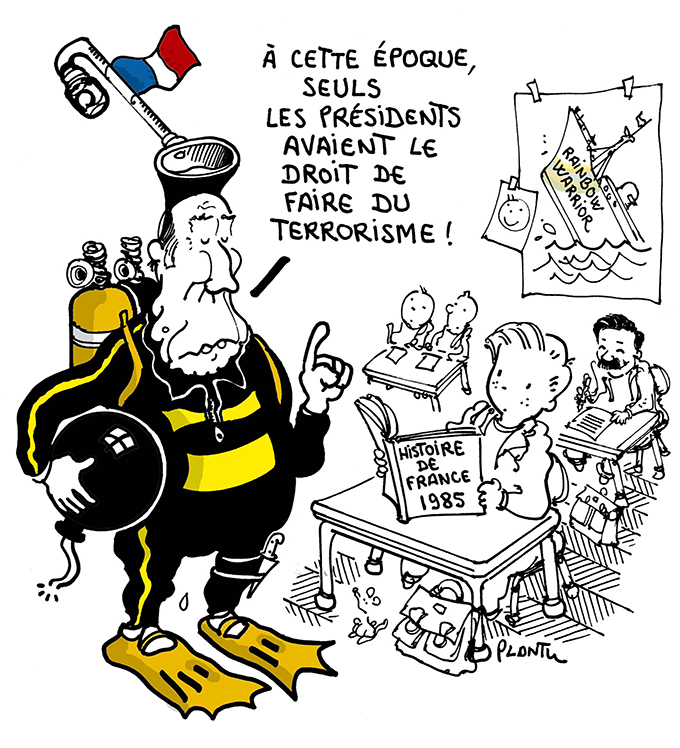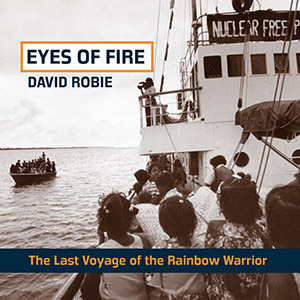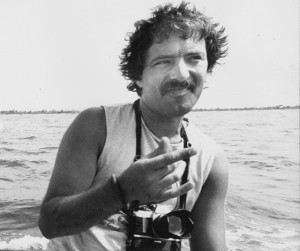
Reviewed by Jeremy Agar of CAFCA and published on Nuclear Free and Independent Day.
EYES OF FIRE: The Last Voyage Of The Rainbow Warrior,
by David Robie [30 Year Memorial edition]. Auckland, Little Island Press. 2015. 196 pages, illustrated. ISBN 978-1-877484-28-5
This is an updated version of the account of the 1985 sinking of the Rainbow Warrior, first published in 1986. No New Zealander old enough to have been around then will be unaware of the incident, but this is a timely reminder for a newer generation of the day when terrorism reached Waitemata Harbour.
Terrorism is supposed to be the last resort of alienated young men from places we know nothing of, but the bomb which blew up the Rainbow Warrior in downtown Auckland was detonated by men and women employed by the Government of France.
If you didn’t know otherwise, you might suppose that some time before the attack France had suffered a traumatic event, because how else might such an odd barbarism be explained? France surely is a modern and agreeable place which merits our sympathy as the target of terrorism, not its perpetrator.
Not really. France is the same place with the same public institutions as it had in 1985, its current President being from the same party — the Socialists for heaven’s sake — as the President back then. Neither, in essence, has its global circumstances changed.
France regarded Greenpeace as ‘terrorists’
 Pollution of land and sea and the degradation of habitats are even more of a problem now than they were last century and you don’t find advanced Western democracies openly calling for the globe to get ever dirtier. And when the Rainbow Warrior docked in Auckland in July 1985, it was in the middle of voyages to draw attention to all sorts of environmental issues. Greenpeace had protested nuclear tests, acid rain, whaling, attacks on dolphins and the dumping of toxic waste. It was doing great work.
Pollution of land and sea and the degradation of habitats are even more of a problem now than they were last century and you don’t find advanced Western democracies openly calling for the globe to get ever dirtier. And when the Rainbow Warrior docked in Auckland in July 1985, it was in the middle of voyages to draw attention to all sorts of environmental issues. Greenpeace had protested nuclear tests, acid rain, whaling, attacks on dolphins and the dumping of toxic waste. It was doing great work.
Not in the eyes of the French State. Their problem was that the Rainbow Warrior was due to sail towards Tahiti and the French islands in the south-east Pacific, where they were testing nukes. If, for the rest of us, it was bad enough that the Russians and Americans were in a perpetual nuclear confrontation which had the potential to wipe us all away, that tension was at least understandable, given the circumstances at the time.
But France had as much reason to want to join the nuclear club as it would have if it started to do so now. That is, zero. It was pure folly.
Being primarily focused on environmental issues, Greenpeace was protesting the very real and obvious threat to marine life. The French of course said that their tests were clean. Which prompted the obvious response that they should, therefore, test their bombs in mainland France. Rainbow Warrior had just arrived from the Marshall Islands, where the US had long polluted (and where areas are still uninhabitable) with nuclear bombs.
By 1985, France had conducted 193 tests in the Pacific and it wasn’t done yet. France (still) pretends to believe that its overseas colonies are no different politically from Paris or Marseilles, so it felt able to treat the New Zealand government, then beginning to respond to Greenpeace’s campaign for a nuclear-free Pacific, as an ally of its activities, which France labelled terrorism.
Staked out on watch
So it was that one winter’s night on Tamaki Drive boat club members, who had been the target of thieves, were staked out on watch when a speedboat landed. Two people got out, dumped the boat’s engine in the water, and were then picked by a car driven by someone in a frogman suit. The yachties noted the car’s plate number.
A later search of the water came up with water bottles made in France. NZ’s petty criminals had enabled the police to arrest France’s state terrorists.
A Frenchwoman who joined the open activities of Greenpeace in Auckland apparently expressed hostility to the idea of independence for New Caledonia and support for France’s bombs, both opinions being the last things you’d expect to hear around Greenpeace. She advanced the rationale that nukes were needed as otherwise “we risk becoming like Finland, which is so influenced by Russia”.
Hearing this ingénue, an experienced observer who knew European history would have intuited that she had been indoctrinated by an older and nostalgic extremist as no-one else had worried about Finnish sovereignty since about 1940. She turned out later to have been a spy.
While it might not be surprising that no local NZ activist would have suspected her, it is surprising that an agent of the French secret police was so gauche.
It seems that the French didn’t know enough of their own history to have created a convincing persona for their agent, who would have been detected had she operated in a more experienced milieu.
Operationally, too, French tactics were clumsy. Twice before they had sunk ships, and both times they achieved nothing beyond discrediting the activities they were hoping to defend.
And just as its secret police have been amateurishly incompetent, so has its political class. David Robie tells us in Eyes of Fire that theories from the political elites in France included the assertion that low-tech Greenpeace was about to advance on French Polynesia with an armada so loaded with the latest gadgets to thwart the tests that the nuke programme would have to be abandoned.
It was said that Greenpeace was financed by BP to maintain its oil interests, that the UK’s MI6, the South African secret police and the Soviet’s KGB had infiltrated Greenpeace. The latter, an old favourite, was picked up a naive NZ media and across the Tasman in the Australian. This detail is significant in that, as a “quality” Tory broadsheet with sophisticated journalists, the paper must have known the claim was suspect. Ideology trumps truth every time.
The rhetoric did not often reach eloquence. One letter to the Greenpeace office after the bombing warned of the traitors ready to deliver the country to the commies. They included “pacifists, hooligans, hippies, trade unions, PLO, Khomeinists, Labour terrorists – all the same riff-raff, all KGB agents.”
No wonder the correspondent concluded with: “Revenge. Better dead than Red. No more Vietnams”. For years serious and educated people had been debating this dilemma of whether they would prefer to be crimson or expired.
Exact opposite of intended result
You’d think that the combined resources of the French elites would have come up with something better than these childish conspiracy theories, but perhaps the greatest of the many asinine calculations of the French State was its assumption that blowing up a Greenie ship in an allied country on the other side of the world would help it to carry on poisoning the South Pacific.
Instead, inevitably, international outrage raised Greenpeace’s profile enormously. It is no coincidence that the peace and environmental movements around the world became increasingly popular from the mid-1980s.

Only one man was killed, a Portuguese-born photographer, Fernando Pereira, but there could easily have been a high death toll. The frogmen who placed the bomb timed it to detonate just before midnight when normally there would have been many others in their cabins, but most happened to be on shore that night.
Robie himself had been on board when the ship docked in Auckland, having sailed from the Marshall Islands.
Even after the event, after the terrorists were caught, President Mitterrand’s France knew no shame, and the dirty tricks continued. Now perhaps there’s some resolution, some (in the irritating vernacular of the day) closure.
In 1987 – after Robie’s original account came out – the Rainbow Warrior was sunk off Matauri Bay in Northland as a likely future marine habitat for divers to explore. And in 1996 France signed the nuclear test ban treaty.
Robie’s professional life has been devoted to the peoples of the Pacific. A journalist and university teacher, he’s written a series of investigative accounts of the struggles of the island nations against big power politics.
Eyes Of Fire is an excellent production, thorough and informed with a restrained passion, with interesting photographs. French politicians, by and large, might now be behaving in a more acceptable fashion, but the global issues that Robie has analysed – of pollution and violence and the stupidity and corruption of power – still demand our witness.
This review of Eyes of Fire was written for CAFCA’s Foreign Control Watchdog 141 magazine April 2016 and has been republished with permission. The publisher Little Island Press’s companion website for the book, Eyes of Fire: 30 Years On, features articles and a photo gallery by the author David Robie; an article by French journalist Pierre Gleizes; author of Rainbow Warrior Mon Amour; and more than 40 video interviews and stories featuring the protagonists by AUT University student journalists.









































Another example of powerful states determined to protect their defence interests is the longstanding UK and also US determination to hang on to the Diego Garcia base after expelling the population and rejecting their right to return, even creating a huge marine reserve to ensure their non return. See eg Wikipedia article Chagossians.
Comments are closed.